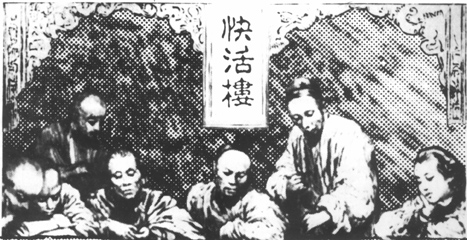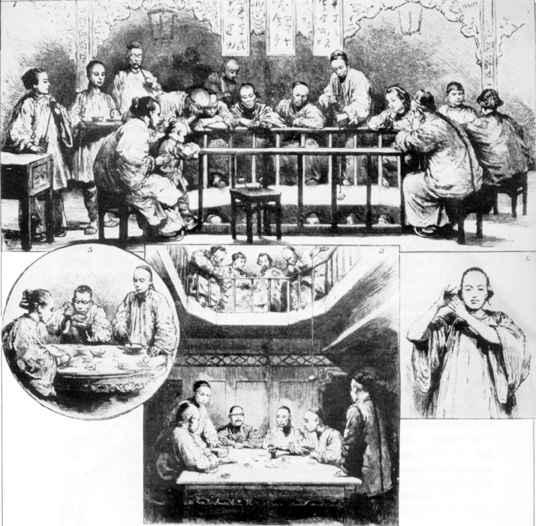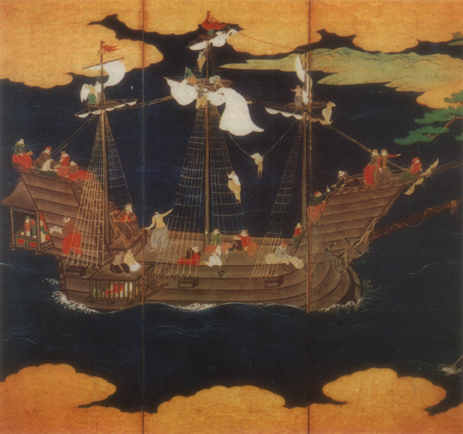
A festive atmosphere originates from where the Rua das Estalagens and the Rua dos Mercadores weave themselves into an intricate web. From here, in these dusty backstreets, splashed with colour and patched up with red, an exuberant spirit rushes through the city.
Here is where the heart of the festivities lies, offered joyfully on the scarlet-red altars spattered with gold where the New Year first descends. And the New Year remains smiling on a throne fabricated from beliefs and superstitions manifested in each colourful carving, each lucky word, each bunch of half-burnt incense sticks whose ashy heads droop towards the ground.
Under the eaves of the little houses on a floor carpeted with all kinds of rubbish, happy children with chopsticks and china bowls pick up yellow rings of seasoned noodles. They sit at a rough table out in the stony darkness. Little girls show off, in elaborate gestures, the bright sponge butterflies decorating their shiny black hair. With ruddy-cheeked little boys they set off firecrackers or scatter a thousand shimmering lights in an arabesque from the most daring of fireworks, filling everything with the joy of their childish hearts.
In the niches which have been carved out under the stone doorways and lined with red, burnt out incense sticks stand witness to their vigil during the recent sau-soi. The smell of clean washing still resisting the smoke and perfume from the smouldering joss sticks wafts through half-open doors. In the darkness inside, where light is muted into shadows, there are flowers, joss sticks and the God of Wealth who stands austere with his eternal promise. Colourful lanterns decorated with big watercolour lotuses hang from the ceilings.
Outside in the street children continue to play while women hurry past, clutching their exquisite hap-lo decorated with painted butterflies and large plum blossoms in all shades and varieties. Further on, down the street, gilded dragons shine and seem to fly on brilliant suns. Golden triangles pin lucky papers at ground level. On some of them there are two mun-san with pink cheeks, smiling definatly from beneath their headdress of greenish feathers. Gaudy-coloured paper lanterns hang from thick ropes and gently swing above the tubes of rosy light, forming characters which trace happiness in an elegant arabesque.
Sweetmeats spill out of jars. Crystallized sugar covers the little mounds of dried fruits and snacks like opaque glass, clouding their colours.
A man snoozes in his delapidated rickshaw, its stuffing hanging out. His clothes are shabby and full of holes, the same oyster shade as the muddy water of the river. His blanket is no more than a grimy rag, torn and useless.
Nearby, the splendid brown walls of the Fai-vut-lau rise up, throwing a subdued yellow light onto the street from the edges of the old blue drapes. The building stretches up to Heaven in successive floors as if in flight from earthly temptation.
Inside there is the distant sound of firecrackers. Whoever goes in takes with them the happiness which fills the streets, shining from every passing face, every smile offered, every burst of laughter from a child, every explosion of firecrackers. The happiness goes in, but not to stay. Instead, it exits in the wake of someone who is leaving, or evaporates in the shattered illusions which fill the interior, in the despair trickling from heavy hearts.
 Gambling Den - Illustration from "The Graphic" (Hong Kong), 22nd. of June, 1889 (taken from Hong Kong Illustrated, 1981, John Warner Publications, Hong Kong).
Gambling Den - Illustration from "The Graphic" (Hong Kong), 22nd. of June, 1889 (taken from Hong Kong Illustrated, 1981, John Warner Publications, Hong Kong).
Brilliant light beams down on the large gambling tables, pouring from each white enamelled lamp-shade serving as a fatal attraction. A sea of heads vibrates with expectations, surrounding each table where the coloured spots of the dice are displayed on a large jade green rectangle. In the corners, the "tai" and the "siu" announce their challenge to those who least believe in fickle luck. Hands tremble and Hong Kong notes and coins are tossed onto the "tai" and the "siu", number 12, number 9 and any other number that the benevolent gods and malevolent spirits of temptation turn up.
Above, there is an oval gallery with a wooden veranda. A new line of gamblers forms, peering over the edge as the little dark baskets filled with coins and notes are lowered on a thin rope. In another corner, an employee turns over the slippery rectangles in response to indications from each player. Everyone's eyes are glued to the long table covered in notes where hopes have gelled.
Halfway down the table, on the other side from the balcony, an impassive employee with a faint trace of a smile, monotonously, carefully, turns a large black semi-spherical drum, its base flattened out and set in a silver ring where the light, reflected, dances. The others observe with stone-set faces, their muscles taught. A cashier with greying hair smiles, indifferent to the money accumulating in little mounds on the tabletop or passing through the large wooden box he keeps in front of him for payments and receipts. Slowly, he sips a perfumed, golden tea infused from "soi-sin" blossoms which he pours from a white china teapot decorated with flowers. A light haze hangs in the air produced by trailing smoke, swallowing up the light and making breathing heavier.
The dice-thrower shouts out the first notice in a guttural, steely monotone, his voice like two sheets of metal being grated together. The second and third notices follow close on each other in the same monotone, the last banknotes falling like sudden rain on the numbers. Unperturbed, his eyes seeking out nobody or else letting them rest on an equally impassive companion, the man lifts the black, shiny lid of the drum and pulls out the three ivory dice spotted in red and black, keeping them away from the inquisitive gaze of the onlookers for as long as possible. And the number is slowly whispered by the man with the dice. His task over, he waits for the payments to be finished before he once again covers the drum and shakes it.
A shudder runs through the gamblers as they squash closer together along the long green-covered table crowded with numbers. Eyes glisten, faces freeze and the silence is interrupted only by the odd exclamation of delight or disappointment. Somebody receives some notes and surreptitiously withdraws. Many remain to search in vain for the silver lining which never appears.
Once again the notes are thrown onto the table. The game is at a low ebb and in the hope of winning, the three slim strokes of the "siu" attract a pile of notes. The shiny black ball turns once more in slow rhythmic movements.
In the neighbouring compartment there is the same heavy smoky atmosphere. Scraps of paper, cigarette butts, are trampled into the ground. Beside the wall, dark blue enamelled vases serve as ashtrays and spittoons. A rat crawls sleepily along the skirting board, blending into the wall. Nobody notices.
The light shines from a large skylight down on the table where people are playing fan-tan. The square metal chips engraved with numbers draw the gamblers as if they were magnets. At the far end of the table there is a pile of white buttons sitting like mushrooms without a stalk under a bell-shaped metal cup. Ferrywomen, coolies and artisans dressed in faded cotton tunics rub shoulders with other clients wearing silk tunics or serge suits. Here everyone is a member of the same family, pushing without looking at his neighbour, concentrating only on the game.
From time to time an old man lifts the cup with a waxen hand and places it over the pile of buttons. The number caught within its smooth metallic confines is up to luck but the coins and notes pile up on the metal chips, the gamblers fixing their gaze on the cup.
Silent expectancy hangs in the air. The cup is finally removed and hurriedly the buttons are divided into groups of four with the aid of a little ruler. With an expressionless face, broken only by the flash of golden teeth the man drones out the number of buttons left over from the speedy division.
Immediately, another employee takes the notes from the numbers which have lost and adds them to those on the number which was blessed by the gods. The gamblers take up their stance once more and notes and coins shower down on the metal chips in a swan-song or victory hymn.
New Year! The time for hopes renewed. The New Year demands that luck should be put to the test. Mysterious dice roll underneath the rounded black cover and white fan-tan buttons pile up like new moons full of promises.
Men pulled along by the thought of the New Year come into the den to gamble. In the depths of their pockets the coins and notes which have been so lovingly caressed are pulled out and placed on the numbers where their fate will be decided.
New Year! The gambling dens fill up with hopes and disappointments. And men gamble to start off another year, enebriated by the sweet and sour taste of hope.
And men gamble... And why not? For after all, Life itself is a game in which some win, others lose and the rest cheat.
GLOSSARY
Fai-vut-lau: Chinese gambling den
Fan-tan: Chinese game played with
buttons
Hap-lo: Round wooden box with several
compartments containing the
crystallized fruits and sweets
which are exchanged
at New Year.
Mun-san: Door gods
Sau-soi: Wake to see in the New Year
Soi-sin: Camellia-scented tea
Siu: Little
Tai: Big
Translated from the Portuguese by
Marie Imelda Macleod

The "Great Ship"
a record of the enormous impact the arrival of the Portuguese had in Jaapan in the middle of the XⅥth Century. This detail from a namban-byobu (Southern Barbarian picture-screen) with six panels (Suntory Art Museum, Tokyo) portrays the "Great Ship" in Nagasaki harbour. Painting by a Japanese artist from the famous Kano school (end of XⅥth century beginning of XIIth century)
*Lecturer in the Faculty of Social Sciences at the New University of Lisbon; anthropologist and researcher; author of several books dealing with the Ethnography of Macau.
start p. 87
end p.